
North Central Louisiana Folk Traditions1
By Susan Roach
I will lift mine eyes unto the hills from whence cometh my help. My help cometh from the Lord which made heaven and earth. -- Psalms 121:1-2 (Scripture often cited at funerals)
God give it to me. I can't get rid of it. I wouldn't want to if I could; I wouldn't take a gold guinea for what I know. -- Dennis Clark2
I'm just gifted, I guess. -- Howard Henry
The country agent had a fire; I had just finished a "Fence Row" [quilt]...and I give it to the county agent...It's helping somebody else, I guess; it's more blessed to give than receive. -- Iska Walker
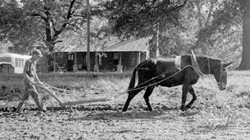
The north central Louisiana people maintain a vital complex of folk traditions which are bound up in a traditional Protestant worldview focused on God as the creator of Earth, the land, and giver of all worldly goods, help, and spiritual blessings. One has only to listen to a typical blessing offered for a meal as an open expression of this view: "Our Father in Heaven, we thank Thee for the many blessings of life, especially for this day and this food." Although some people do not openly express their religion, their lives reflect the powerful Protestant work ethic and the importance of reciprocity. While some may attribute their skills to hard work and practice, many other tradition bearers think of their talents in music, crafts, farming, or building as gifts from God which they are obligated to use and share with others. Many are also aware that their traditional abilities are a precious heritage from their ancestors which they wish to hand down to others. The complexities of this heritage may be better understood if the variety of traditions are isolated and categorized for examination purposes. In reality, they cannot be separated, for the farmer sings in the fields and prays over the peas, and the folk architect hunts in the hills.
Folk Architecture And The Landscape3
He said, 'How are you goin' get that [log barn] down?" I said, 'Well, I've got a little boy that weighs about 125 pounds. I'm goin' get up there and take the logs off and drop them and he's going to catch them and put them on the wagon.'... He said, 'Now I've got to see that.' I said, 'Well, be out here in the morning, and we're fixing to start taking it down.' We done had the tin and the rafters and everything off. We were ready to take the logs off. We took a rafter and stood it up over here and over yonder, and I'd get up there and prize it up [the log], and I'd let it slide down that rafter. We'd let about three or four slide down and then get down and put them on the wagon. I put the whole crib on the wagon at one time. -- Victor Tabor
Aw, nothing's built right these days; you just have to do it yourself.-- Homer Eaves
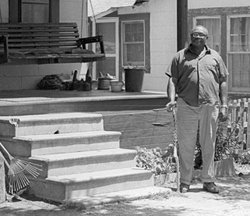
Traditionally, the typical small farm had several buildings in its settlement pattern on its 40-200 acres, which were usually arranged in a loose cluster. Generally, the barn (usually a double pen) was located behind the house on the right or left or across the road. A garden plot was usually near the house. The smokehouse was behind the house and the syrup mill near the bottomland (Wright 1956: 113). Sheds or wagons and other farming and blacksmith equipment and later privies might be situated counter to the barn. If the well was not near the house or on the porch, it might have its own shelter.
Many farmers such as Homer Eaves of Simsboro, and Victor Tabor, of Spearsville, have farms which follow and expand upon this basic model. Both have built log barns on their farms; Tabor's barns are both behind his house and across the road, and one is actually an older barn he tore down, moved, and rebuilt. Eaves' are clustered behind his house. Eaves' farm began with his small shotgun house where he "batched" until his marriage when he had a bungalow built. He built the numerous buildings on the farm, including a rat-proof barn (or crib), mule barn, cow barn, weighing shed, blacksmith shop, saddle shop, smokehouse, and equipment sheds.
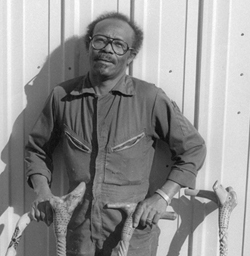
Although neither of these farmers makes his own syrup now, there are scattered working syrup mills in the region; however, the majority are pulled by tractors instead of mules.
In the past, split-rail snake fences were used to protect cultivated fields from open range livestock, but today's traditional farms use wire fences, and open range is rare. Today's small farms also have miscellaneous, often crudely constructed, shelters for hogs and chickens, with the later custom of penning livestock and the increase in the popularity of chickens.
After the plain single or double pen log cabin, the most common farm house type in early rural North Louisiana was the dogtrot, a double pen house with an open hall separating the pens. Chimneys were located outside at both gable ends and a porch was often attached (Wright 1956: 27-28). Shed rooms or L-additions might be made on the back of the house. With the coming of the sawmill in the late 1800s, many dogtrots were built with machined lumber rather than logs. A few log and many frame dogtrots are still present in North Louisiana (Martin 1983). Most of the dogtrots (halls) have been enclosed to facilitate more efficient heating in those still inhabited. The most common house type in rural North Louisiana today (with the exception of the typical brick suburban home) is the bungalow, which is two rooms wide and two or more rooms deep with forward facing gables. A fence, rived paling of 19th century farms and wire of the 20th century, sometimes enclosed the house and yard which was swept clean and kept grass-free with homemade broomsedge, switch cane, or dogwood brush brooms. With the development of the power mower, grass lawns came into vogue; however, there are a few dirt yards remaining in North Louisiana, such as that of Miss Jesse Kendricks, near Homer, and Mrs. May Owen, of Point, who still uses her brush broom for yard sweeping. Some small town yards such as David Allen's are still clean swept (Figure 5).
The country store, a vital part of rural communities in providing essential products and a daily social center for dominoes and conversation, is often a type of folk architecture. Usually the store is of a shotgun or bungalow style (Pulliam and Newton, 1973). Country churches were also frequently built with traditional patterns without architects. Although many of these traditional buildings have been replaced with brick buildings, quite a few remain.
Farming And Animal Husbandry
You learned those things being raised on a farm, not only having those things but learning them and seeing what the fundamental parts of life was all about. This is the part of life you can live with what God gave you, the natural things of life. -- Alvia Houck
You know, out in the field growing something, you're close to God and it makes you think about life and death. I stand there and pray the Lord will give a good crop. --Sarah Albritton
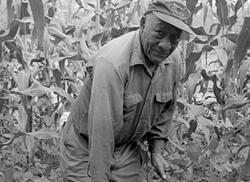
The small farmer after the Civil War until the 1930s actually may have been relatively better off than the planter in north central Louisiana. What little cotton he grew yielded him more net cash proportionally than the planter's huge crop (Shugg 1939: 255-256). Subsistence farming was common in some hill sections of Louisiana until the 1930s when highways and technology made commercial agriculture more feasible (Kniffen 1968: 140). A few such farms remain operated by the older generation.
Several factors have affected the operation of farms in the region. Many farms were left after World War II with no younger generation to operate them. Often the younger farm residents turned to developing industry, perhaps lumber or oil, for jobs. Some of the hill farmers sold land to timber companies (Highsmith 1964: 29-31). In fact, today, timber companies own some of the largest tracts of land in the area.
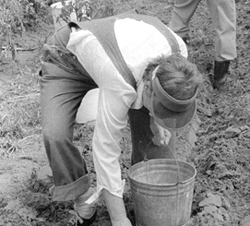
Ultimately, transportation did even more to change the face of North Louisiana. Networks of railroad and highways created new towns along their routes and bypassed others, leaving them to wither away. New towns provided opportunities for rural residents to find new jobs in industry and commerce. Many people from rural backgrounds moving into these jobs brought their belief systems and their folk traditions with them. Although some of these traditions would not be needed in the towns, memories of these were retained; other traditions such as gardening and food preserving were maintained in spite of the urbanizing effects of transportation and communication.
Some of the remaining farmers today began as sharecroppers. Jewel Davenport remembers how his family after years of sharecropping finally got enough money to buy forty acres of their own land.
While north central Louisiana farmers in the past were practically self-sufficient (Lockett 1969: 47-48) and dependent predominantly on farming for their livelihood, few people today draw their complete support from farming. Farmers like Alvia Houck, Pat Otwell, Clonie Otwell, Abie Colvin, and Jewel Davenport have worked in a variety of occupations from oil jobs to highway work to truck driving. Following the example of their families before them, they were not able to totally give up farming. Rather they have continued traditional farming techniques and raised a wide variety of crops and animals.
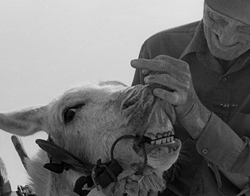
Popular crops grown in north central Louisiana include several types of peas -- purple hull, California pink eye, black-eyed, crowder, speckled, lady, little cream, and red rippers just to name a few -- field corn, sweet corn, sweet and Irish potatoes, string beans, butter beans, cabbage, turnip greens, collards, tomatoes, cucumbers, hot and bell pepper, watermelons, and cantalopes (Figure 1). Many farmers also often have small orchards and vineyards including fruits such as peaches, pears, apples, plums, and muscadines.
Although some of the farmers have been influenced by the agricultural extension service, many of today's farmers such as Annie Rene Harris and Jewel Davenport follow traditional practices of planting by the signs. In general, according to Mrs. Harris, "Anything that grows under the ground, you plant dark nights; on top of the ground, plant light nights. Three days before the full moon and three days after, that's a good time to plant anything that grows on top of the ground. Under the ground, plant before the new moon."
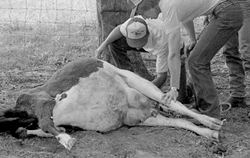
Based on his experience, Jewel Davenport, who learned from his mother to plant such crops as peas when the moon was full, thinks the planting by the signs can make a difference in the success of a crop. Most farmers use the Ladies Birthday Almanac, still provided free in many drug and general stores in the area, to check the stages of the moon.
In addition to traditional planting times and techniques, cultivation and harvesting have certain traditional techniques which are learned through example and practice on the farm. Most of these techniques are accomplished with old commercial equipment still in use on older farms (see Figures 1 and 2). Many farms still use mules, horses, or donkeys for plowing with this equipment; most older farms choose mules over tractors even when they own tractors because the animals can do a "prettier" job. A mule or horse can get closer to the young plants without damaging them and consequently, do a better job. They can also get into the corners of the small fenced garden, a feat which a tractor cannot do.
Along with traditional farming techniques, farmers must also be familiar with animal care practices (Figure 3). Farmers such as Victor Tabor, Homer Eaves, Richard Bryant, and Annie Rene and Walker Harris still have a number of animals on their farms, including mules, horses, cows, pigs, donkeys, chickens, ducks, guineas, geese, dogs, and cats. Each animal has its own requirements for health and food and its own set of ailments, many of which are cured right on the farm without veterinary help. Some farmers such as Dennis Clark, of Spearsville, are known for having a knack for healing or dealing with animals. Many old cures for healing certain problems have been handed down along with techniques for dealing with difficult births (Figure 4). Expertise in this area is highly valued, as is talent for breaking horses or mules to ride or plow.


